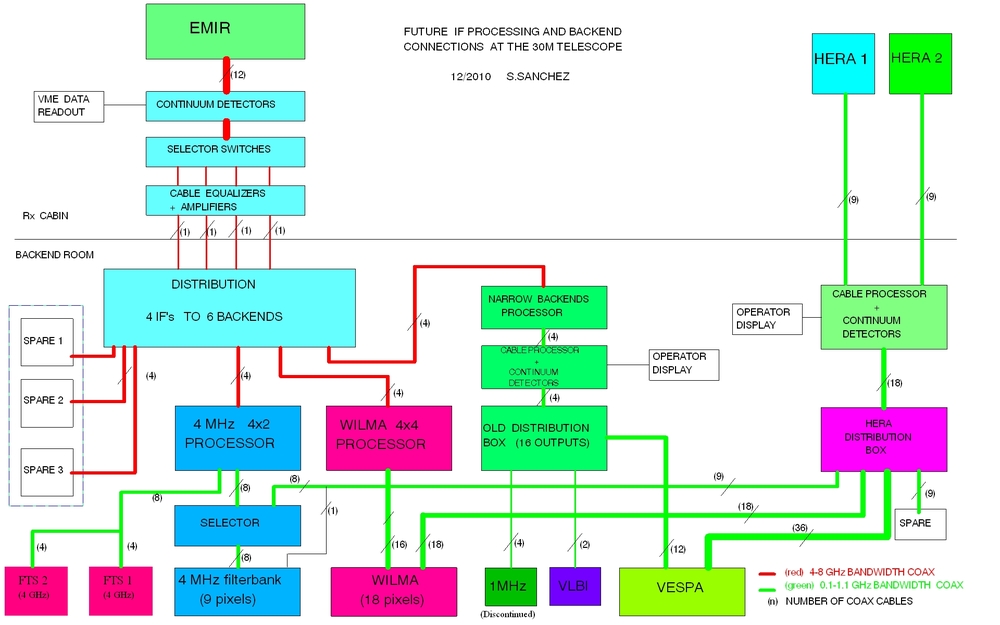Contents
Backends for EMIR and HERA
Backend |
Type |
Channel Width |
Bandwidth |
Receiver (width mode) |
Remark |
|
4 MHz |
Filterbanks |
4 MHz |
8 or 9 x 1GHz |
EMIR, either HERA1 or HERA2 (wide) |
|
(1) |
WILMA |
Autocorrelator |
2 MHz |
16 or 18 x 930 MHz |
EMIR, HERA (wide) |
|
(2) |
FTS |
FFTS |
195 kHz |
8x4 GHz |
EMIR, HERA |
|
(3.1) |
FTS |
FFTS |
50 kHz |
|
EMIR, HERA (narrow) |
|
(3.2) |
VESPA |
Autocorrelator |
3.3 kHz-1.25 MHz |
10-512 MHz |
EMIR, HERA (narrow) |
|
(4) |
XPOL |
VESPA |
40kHz-1.25MHz |
120-640MHz |
EMIR |
|
(5) |
nbc / continuum |
continuum |
1 GHz |
|
|
|
(6) |
bbc |
continuum |
8 GHz |
|
|
|
(7) |
See here, for the present status of the backends. For more information on the capabilities of EMIR, see here. In general, several backends can be attached to one receiver. Exceptions are listed below. The pako manual describes in detail how to configure the backends.
The new FTS and bbc backends are online! <CK 2-Aug-2011>
4MHz Filterbank: max. 9 parts; use of the 4MHz filterbank excludes the use of VESPA on the same receiver. Frequency switching not available. While the channel spacing is 4MHz, the 3dB width is 5.4MHz and the noise equivalent width is 6.5 MHz
WILMA: The Wideband Line Multiple Autocorrelator for EMIR and HERA
Fast Fourier Transform Spectrometer (FTS): In July 2011, we installed 24 FTS units to cover 32GHz of bandwidth. The resolution is 200 or 50kHz. They are available to all observers since 2-Aug-2011. See the short commissioning report and the document of Gilles Butin on the Spectrum Slicers for FFT Spectrometers. Also see the backend status page. These FTS have been built by Bernd Klein at the MPIfR/Uni Bonn and distributed by Radiometer Physics. See two recent papers of 2009 and 2008 and a
presentation of 2011. At present the exact frequency ranges are (GP, 21-Jul-2011):
- EMIR wide mode: 20737 channels (~4050.195MHz) centered at 5975.0MHz. First channel at 3950.0MHz, last channel at 8000.0MHz. The first 50MHz are "bonus" bandwidth, which will be very useful if the outer folding frequency is 15.95GHz. - EMIR narrow mode 37275 channels (~1820.068MHz) centered at 6200.0MHz First channel at ~5289.990MHz, last channel at ~7110.010MHz. - Hera wide mode 5377 channels (~1050.195MHz) centered at 609.375MHz. First channel at 84.375MHz, last channel at 1134.375MHz. - Hera narrow mode 12814 channels (~625.684MHz) centered at ~397.192MHz. First channel at 84.375MHz, last channel at ~710.010MHz. As long as we keep the current folding frequency for outer bands, outer band are always at 15680-inner in MHz, so in the case of EMIR narrow mode, 15680-6200 = 9480. (GP, 19-Sep-2011)
Table 1 In the winter semester 2010/11 we had offered 8 units covering 2x4GHz of bandwidth with a fixed resolution of 195kHz for EMIR.
VESPA: The Versatile SPectrometer Array. Up to 18000 channels. In connection with HERA (9 pixels) the following combinations of resolution (kHz) and bandwidth (MHz) are possible: (20/40), (40,80), (80, 160), (320,320), (1250, 640); VESPA User Guide (2002), Summary in IRAM Newsletter No. 54 (Dec 2002), local contact: G. Paubert
XPOL: Line and continuum polarimetry is possible at the 30m using a new type of IF polarimeter designated XPOL. The central feature of XPOL is the correlator VESPA where the IF signals from two orthogonally polarized receivers are cross correlated to determine the four Stokes parameters. A manual is in preparation, contact: C. Thum
The old continuum backend, now called narrow band continuum backend nbc with 1GHz width, is still available for HERA, and also for EMIR.
The broad band continuum backend bbc with 8GHz width, fully exploiting the bandwidths of EMIR, is available since 2-Aug-2011. bbc cannot be connected to HERA.
Decommissioned backends:
MAMBO2 has been decommissioned mid 2011. ABBA1 and ABBA2 (Adc Bolometer Backend) were the bolometer backends for the MAMBO 1mm camera, i.e. dedicated PCs connected to the bolometers.
- The 1MHz filterbank has been decommissioned in 4/2008: max. 4 parts; series, parallel, or mixed mode possible; using the 1MHz filterbank with 1GHz bandwidth excludes the use of VESPA with the same receiver. The filterbank can be shifted in multiples of 32MHz from the center frequency of the connected receiver.
Distribution of intermediate frequencies (IFs) to the backends (Status: July 2011)
IF distribution installed end of June 2011
Figure 2: IF distribution since July 2011
Old IF distribution (Status: June 2011)

Figure 1: IF distribution (16-Dec-2010 SS/CK)

